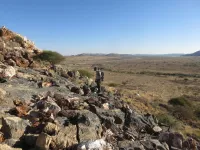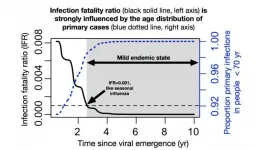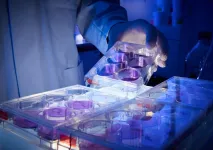(Press-News.org) Philadelphia, January 12, 2021 - A special issue of the Journal of the American College of Radiology (JACR), published by Elsevier, challenges conventional wisdom across the imaging community. This collection of articles, the "Provocative Issue," presents extreme opinions on pressing issues confronting radiologists with the deliberate aim of sparking positive dialog and debate that will lead to innovative solutions to improve patient care and imaging-related outcomes.
The issue is guest-edited by:
Caroline Chung, MD, MSc, Director of Advanced Imaging - Strategic Initiative and Director of Imaging Technology and Innovation, Department of Radiation Oncology and Diagnostic Imaging, The University of Texas MD Anderson Cancer Center, Houston, TX, USA;
Christoph I. Lee, MD, MS, Director, Northwest Screening and Cancer Outcomes Research Enterprise, Department of Radiology, University of Washington School of Medicine, Seattle, WA, USA; and
Reed A. Omary, MD, MS, Chairman, Department of Radiology and Radiological Sciences, Vanderbilt University Medical Center and School of Medicine, Nashville, TN, USA.
"We expect this special issue will provoke strong reactions from our readers, ranging from shock, offense, and even disgust," explain the co-guest editors. "The articles were deliberately selected to challenge the conventional wisdom across the imaging community."
"We live in a divisive time of polarization on social, political, and scientific fronts. Yet, when oppositive or counter-intuitive points of view are brought forward, meaningful discussions can lead to new perspectives and novel solutions," write the co-guest editors. "This special issue will challenge us to consider bold ideas that go against the grain. Our goal is to spark debate so that radiology can continue to evolve within our complex Darwinian healthcare ecosystem, leading to greater benefits for society."
Articles in this special issue encompass the five content pillars of the JACR: health services research and policy; clinical practice management; data science; training and education; and leadership. Some of the provocative questions posed are the following:
Are prospective employer-initiated whole-body cancer screening programs a benefit and incentive for employees?
Matching imaging services to clinical context - can less be more?
Rethinking the approach to artificial intelligence (AI) for medical image analysis - is there a case for precision diagnosis?
Should we rethink patient consent in the era of AI and big data?
Can clinician-scientists survive in the modern era?
Is there a case for vertically integrating emergency radiology into emergency medicine?
Should there be duty hour limits for radiologists?
Are we over-supporting junior faculty and neglecting mid- and late-career faculty planning?
Of particular note are two featured articles that debate the paradox of scarcity and discuss potential solutions. The use of physician extenders, also known as nonphysician practitioners (NPPs), in medicine has increased over time within a multitude of specialties including radiology. Radiologists are expensive to train and then spend too much time on low-complexity tasks and too little on high-complexity tasks, notes Saurabh Jha, MBBS, MS, Department of Radiology, University of Pennsylvania, Philadelphia, PA, USA, who makes the point for training physician extenders to take on the less complex cases.
"Radiologists should train and supervise physician extenders to read portable chest radiographs, which should eventually be relinquished to them, so that we can focus on tasks exacting more skill and more befitting of our rigorous medical training," argues Dr. Jha. "Perhaps physician extenders reading serial radiographs can free radiologists to advise clinical teams on those serial radiographs."
In a counterpoint article, Daniel A. Ortiz, MD, Summit Radiology Services, PC, Cartersville, GA, USA, and colleagues observe that although labor costs have been reduced and radiologists can focus more on complex imaging studies and interventional procedures, there are unintended consequences of NPPs in practice that could diminish physicians' role as healthcare providers. They therefore encourage radiologists to consider an alternative to NPPs in diagnostic radiology: the incorporation of rapidly evolving AI algorithms into daily practice.
"Narrow AI algorithms can easily be integrated into existing workflow and amalgamated into a platform for use by radiologists," the authors argue. "Many of the gains touted by proponents for the use of NPPs, such as efficiency, will likely be soon realized through AI to the effect of preserving the radiologist's role, supplemented by AI. The ultimate goal for our community should not be relegating work to others but rather to work the complexities of developing a future in which we empower ourselves to remain at the helm of the imaging care to our patients' benefit."
The co-guest editors comment that the ever-increasing workload and the threat of radiologist workforce burnout will force us to consider how to keep up with imaging demands. Physician extenders and AI solutions are only two possibilities for practices to consider.
A final article provides an entertaining voyage into space and how the experience around radiation exposure within medicine can be applied to radiation exposure considerations in suborbital space tourism.
"By exploring the provocative, we hope this special issue will serve as a catalyst to advance the field and expand the confines of radiology," conclude the co-guest editors.
INFORMATION:
ATLANTA - JANUARY 12, 2021 - Overall cancer death rates in the United States dropped continuously from 1991 through 2018 for a total decrease of 31%, including a 2.4% decline from 2017 to 2018. The news comes from the American Cancer Society's annual Cancer Statistics, 2021 article, appearing in CA: A Cancer Journal for Clinicians, and its consumer version, Cancer Facts & Figures 2021. This year marks the American Cancer Society's 70th anniversary of reporting this data to inform the nation's fight against cancer.
The report estimates that in the U.S. in 2021, almost 1.9 million (1,898,160) new cancer cases will be diagnosed and 608,570 Americans will die from cancer. ...
Remarkably well-preserved fossils are helping scientists unravel a mystery about the origins of early animals that puzzled Charles Darwin.
Analysis of the 547 million-year-old remains has enabled researchers to trace the ancestry of some of the world's earliest animals further back than ever before.
Their study has uncovered the first known link between animals that evolved during the so-called Cambrian Explosion some 540 million-years-ago and one of their early ancestors.
Until recently, little was known about the origins of animals that evolved during the Cambrian event because of a lack of well-preserved fossil evidence.
The mysterious origins of animals that evolved at this time - when the diversity ...
Core technology includes promising bivalent single-domain antibodies simultaneously targeting two surface structures of the viral spike protein.
Lead candidates DIOS-202 and DIOS-203 are engineered for high potency and their potential to avoid the emergence of escape mutants.
DIOS-202 and DIOS-203 entered into accelerated development to initiate clinical studies later this year.
BONN, Germany, January 12, 2021 - DiosCURE SE announced a publication in Science describing its core technology of multivalent single-chain antibodies with a unique molecular mode-of-action to inactivate ...
While most people are able to eat a normal diet, many of those managing distinct nutritional requirements related to a disease or health condition rely on medical foods. Medical foods help patients meet their nutritional needs, often improving nutritional and health outcomes and quality of life. A recent publication in Current Developments in Nutrition, titled "Medical Foods: Science, Regulation, and Practical Aspects. Summary of a Workshop," shares the historical and regulatory context of medical foods and perspectives on their role in the future.
Medical foods help patients manage their nutritional needs, yet it can be very difficult for patients to have access to them. In August 2019, the Healthcare Nutrition Council (HNC), in partnership with the American Society ...
What is the endgame for SARS-CoV-2, the virus that is causing worldwide devastation? If it becomes endemic -- circulating in the general population -- and most people are exposed in childhood, SARS-CoV-2 may join the ranks of mild cold-causing coronaviruses that currently circulate in humans, according to a model developed by Emory and Penn State scientists.
The model, published January 12 in Science, draws upon studies of the four common cold coronaviruses and SARS-CoV-1. For those viruses, the term "herd immunity" is incomplete and possibly misleading, says ...
Antibodies are an important weapon in the immune system's defense against infections. They bind to the surface structures of bacteria or viruses and prevent their replication. One strategy in the fight against disease is therefore to produce effective antibodies in large quantities and inject them into the patients. The outgoing US President Donald Trump probably owes his rapid recovery to this method. However, the antibodies used to treat him have a complex structure, do not penetrate very deeply into the tissue and may cause unwanted complications. Moreover, producing antibodies is difficult and time-consuming. They are therefore probably not suitable for widespread use.
Mass production in yeast or bacteria
"We focus on another group of molecules, the nanobodies," ...
Researchers at Karolinska Institutet in Sweden have developed, in collaboration with researchers in Germany and the U.S., new small antibodies, also known as nanobodies, which prevent the SARS-CoV-2 coronavirus from entering human cells. The research study, published in Science, shows that a combined nanobody had a particularly good effect - even if the virus mutated. According to the researchers, the nanobodies have the potential to be developed into a treatment for COVID-19.
Specific proteins, spike proteins, on the surface of the SARS-CoV-2 coronavirus help the virus infect host cells. Therefore, antibodies that block the spike proteins and prevent them from binding to the cell can be a way to stop infection.
From the perspective ...
What will the SARS-CoV-2 outbreak look like ten years from now as it passes from pandemic to endemic, maintained at a constant baseline level in populations without being fueled by outside infections? Data from four endemic human coronaviruses, which circulate globally and cause only mild symptoms, may hold some answers, say Jennie Lavine and colleagues. Their analysis of the immunological and epidemiological data for these viruses helped them develop a model to predict the trajectory of SARS-CoV-2 as it becomes endemic. Most importantly, the authors say, their model incorporates distinct components of immunological protection--susceptibility to reinfection, weakening of the disease after reinfection, and transmissibility of the virus after reinfection--that each wane differently. Lavine ...
An immunization strategy tested in mice protects against infection from SARS-CoV-2, as well as from potentially emerging animal coronaviruses, researchers say. The approach could be "used as described or easily adapted" to provide defense against newly discovered zoonotic coronaviruses. In the last 20 years, three betacoronaviruses have caused devastating disease in humans. The global pandemic caused by the latest such virus, SARS-CoV-2, highlights the need to protect against other strains that could present a threat to humans, possibly through a pan-coronavirus vaccine. To support related efforts, ...
Thanks to major progress in the understanding and management of rare congenital diseases and syndromes, many patients with these rare disorders are now living longer lives. With this progress it has become apparent that many non-skeletal rare diseases have an impact on bone mass, bone quality and/or bone metabolism, with potentially severe repercussions for quality of life in adults.
The new paper 'Bone fragility in patients affected by congenital diseases non skeletal in origin', published in Orphanet Journal of Rare Diseases by the International Osteoporosis Foundation (IOF) Skeletal Rare Diseases Working Group (SRDWG), provides ...




